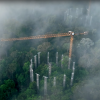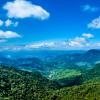
IIASA scientists show that preserving ecosystems and fostering socio-economic development is not a trade-off. On the contrary, an integrated approach is beneficial to national policies. We share examples from India, Brazil, and Indonesia.
Ecosystems support all life on earth, but as a result of human activity, they are increasingly degraded. Ecosystem restoration is extremely complex and often tends to result in significant trade-offs in economic and societal outcomes. Typically, such trade-offs are viewed as the price to pay for a healthy environment, however, IIASA researchers are working to expand this paradigm through a new approach — integrated, biodiversity-inclusive spatial planning.
Researchers are proving that viewing national priorities in other spheres, such as agriculture, as actors, rather than potential trade-offs, can achieve global climate and environmental goals without compromising the development of other sectors. If such an approach proves viable to be adapted internationally, the global agenda would become more appealing to policymakers at the national level.
“Global analysis of ecosystem restoration often focuses strictly on biodiversity preservation or carbon, whereas we want to incorporate the human dimension and the national perspectives into our work,” explains Piero Visconti, IIASA Biodiversity, Ecology, and Conservation Research Group Leader. “We try to ensure that we do not put the benefit for nature against human benefit, but try to unite them and maximize them, using existing legislation and national strategies.”
Different IIASA studies and projects are already exploring the potential of using this approach. For example, a recent study focused on India, led by a former participant of the IIASA Young Scientists Summer Program (YSSP), Trisha Gopalakrishna, shows that there can be a holistic relationship between ecosystem restoration and benefits to humanity, including a reduction in socioeconomic inequality. The study uncovered that actions to capture carbon, restore biodiversity, and support the livelihoods of the people who live near and in the forests, can complement one another. Moreover, integrated plans focused on delivering all of these objectives simultaneously tend to be, on average, 80-90% as effective as plans with a single objective.
In another similar study, scientists used the IIASA GLOBIOM agricultural economic model to identify how to restore the Atlantic Forest in Brazil, while prioritizing food production. Scientists point out that restoration efforts could be significantly more effective if incentives were introduced to make it profitable for small landowners (e.g., by providing financial and technical support to small farmers willing to restore their land, as well as better access to markets for their produce). This work was carried out within the framework of the RESTORE+ project.
As part of the same project, scientists seek to identify the consequences of adopting different approaches to policy in Indonesia, from industrial agriculture to sustainable agriculture, to agroforestry, sustainable forestry, and natural regeneration. Offering such data to the policymakers without necessarily suggesting one particular optimal recommendation, researchers are enabling them to make the decision about the best option and the best combination of synergies to use in their country.
“Our ultimate goal is to address national needs and priorities in a selected country, while simultaneously restoring the ecosystems,” says Ping Yowargana, Senior Research Scholar in the IIASA Agriculture, Forestry, and Ecosystem Services Research Group. “Once we identify effective synergies in one country, we can draw up sets of best practices that can be replicated in similar contexts all over the world.”
References:
Gopalakrishna, T., Visconti, P., Lomax, G., Boere, E., Malhi, Y., Roy, P.S., Joshi, P.K., Fedele, G., et al. (2024). Optimizing restoration: A holistic spatial approach to deliver Nature’s Contributions to People with minimal tradeoffs and maximal equity. Proceedings of the National Academy of Sciences 121 (34) e2402970121. 10.1073/pnas.2402970121. [pure.iiasa.ac.at/19940]
Shennan-Farpón, Y., Soterroni, A.C., Scarabello, M., & Visconti, P. (2024). Using policy scenarios to assess challenges and opportunities for reaching restoration targets in Brazil’s Atlantic Forest. Environmental Research Letters DOI: 10.1088/1748-9326/ad5ab2
News

04 November 2024
AmazonFACE inauguration video (launch of 2nd phase)
02 October 2024
IIASA and Latin American Ambassadors explore new collaborative opportunities

22 August 2024
